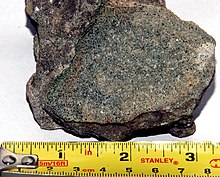Greensand


Greensand or green sand is a sand or sandstone which has a greenish color. This term is specifically applied to shallow marine sediment that contains noticeable quantities of rounded greenish grains. These grains are called glauconies and consist of a mixture of mixed-layer clay minerals, such as smectite and glauconite. Greensand is also loosely applied to any glauconitic sediment.[1][2][3]
Formation
Greensand forms in
Occurrence
Important exposures are known from both northern and western Europe, North America, southeastern Brazil and north Africa. Well known and important greensands are the Upper and Lower Greensands of England and occur within Eocene and Cretaceous sedimentary strata underlying the coastal plains of New Jersey and Delaware. Although greensand has been found throughout Phanerozoic and Late Precambrian sedimentary deposits, it appears to be most common in Eocene, Cambrian, and Cretaceous sedimentary deposits.[1][2]
Brazil
In Brazil, greensand refers to a fertilizer produced from glauconitic siltstone units belonging to the Serra da Saudade Formation, Bambuí Group, of Neoproterozoic/Ediacaran age. The outcrops occur in the Serra da Saudade ridge, in Alto Paranaíba region, Minas Gerais.[5] It is a silt-clay sedimentary rock, laminated, bluish-green, composed of glauconite (40–80%), potassium feldspar (10–15%), quartz (10–60%), muscovite (5%) and minor quantities of biotite (2%), goethite (<1%), titanium and manganese oxides (<1%), barium phosphate and rare-earth elements phosphates (<1%).
Enriched levels of potash have
Great Britain
In
Both Upper and Lower Greensand outcrops appear in the scarp slopes surrounding the London Basin and the Weald. Prominent seams are to be found in the Vale of White Horse, in Bedfordshire, in Kent, Surrey, the South Downs National Park,[8] elsewhere in Hampshire, the Isle of Wight, and the Jurassic Coast in Dorset. Some minor seams are found further west in Devon in the Blackdown and Haldon hills.
The soil of the greensand is quite varied, ranging from fertile to fairly sterile. On the fertile soils

Lower Greensand
The Lower Greensand (known as the Woburn Sand north of the
Upper Greensand
The Upper Greensand is of
Outcrops of the Upper Greensand occur in the southwest of England including the
Properties and uses
The green color of greensand is due to variable amounts of the
In Roman times in Britain, coarse grits derived from the lower greensand were used to line the inner surface of
Recently, glauconitic greensand has become a popular organic soil amendment. The porous properties of glauconite greensand allows for the absorption of water and minerals, making irrigation and nutrient delivery much more efficient (see soil conditioner).[citation needed] Greensand can be used to absorb excess water in clay-rich soils and to prevent water loss in sandy soils.
See also
References
- ^ ISBN 978-0-444-87120-6.
- ^ a b Pettijohn, F. J.; Potter, P.; Siever, R. (1987). Sand and Sandstone. New York, NY: Springer-Verlag.[ISBN missing]
- ISBN 0-922152-76-4.
- OCLC 757072790.
- ^ Moreira, Débora (2016). "Estratigrafia, petrografia e mineralização de potássio em siltitos verdes do grupo Bambuí na região de São Gotardo, Minas Gerais" (PDF). Revista Geociências. 35. São Paulo: UNESP: 157–171.
- ISBN 0-11-884078-9.
- ^ "Upper Greensand Formation". BGS Lexicon of Named Rock Units. British Geological Survey. Retrieved 22 May 2013.
- ^ "South Downs Integrated Landscape Character Assessment" (PDF). Archived from the original (PDF) on 2007-09-28.
- ISBN 1-873010-23-0.
- Stamp, L. Dudley (1946). Britain's Structure and Scenery. New NaturalistSeries. Collins.
- ISBN 0-11-884522-5.
- ISBN 0-85272-478-0.
- ISBN 0-11-880713-7.
- ISBN 0-471-11018-3.
- ^ Henig, M; Booth, P. (2000). Roman Oxfordshire. p. 166.[ISBN missing]
External links
 The dictionary definition of greensand at Wiktionary
The dictionary definition of greensand at Wiktionary- Greensand at the Arkansas Geological Survey
- Glauconite (Greensand) at the Delaware Geological Survey
- Greensand/glauconite, Mindat.org (as a commodity)
- Howe, John Allen (1911). . Encyclopædia Britannica (11th ed.).
